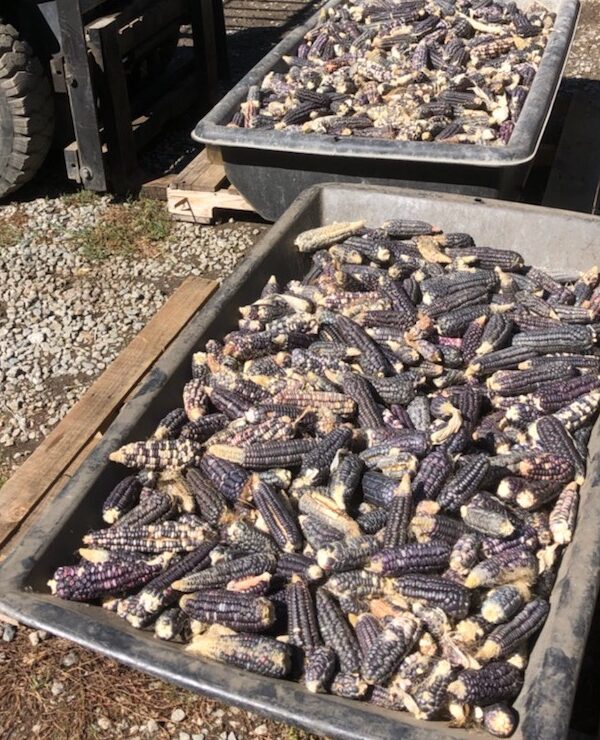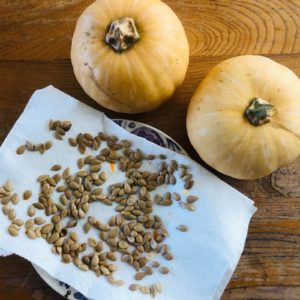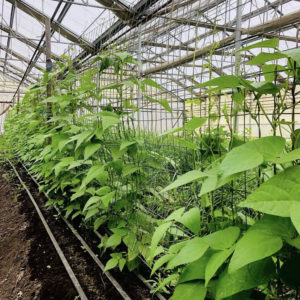The Milpa and the Holy Trinity

We planted the first stage of our little “milpa” this weekend. A milpa is a “corn patch.” The City of Milpitas is named after the little corn patches that characterised the area during California’s Spanish colonial period. But a classic traditional milpa is always more than corn. The Mesoamerican farmers who created the milpa typically grew a diversity of crops in their corn fields. The corn stalks grew high and vining beans snaked up the stalks, using them for support. Broad leaved squash plants would grow between the scattered hummocks of corn, and the dense canopy they formed would choke out the weeds. Crops that we moderns might think of as noxious weeds to be exterminated, like pigweed or lambsquarters, were “quelites” to the farmers of the milpas and they’d gather them to add leafy greens to their diet. A fully realized milpa consisted of Corn, squash, and beans -the Holy Trinity- surrounded by a cohort of useful and nutritious herbs.
 I’m playing around with the milpa idea for fun, and to see how well it works out in practice. I see my milpa as a typical type garden which might be found anywhere along the French-Mexican border. For my hard squash I’ve chosen to plant “Doran,” an heirloom French squash for the Cucurbita moschata- like a butternut, but round, like a pumpkin. I think the Doran hard squash will be an excellent size for our farm’s supporters, since they’re small enough for us to fit in the box and for our supporters to consume in one meal. We received seed for this crop from our friend and neighbor, Zea, at Fruitilicious Farm, who has been saving this old fashion variety. Any purslane weeds that come up in our milpa we’ll let go to seed so that we can have “verdolaga.” Purslane, AKA Verdolaga, which is esteemed as a cooking green in both the French and Mexican traditions.
I’m playing around with the milpa idea for fun, and to see how well it works out in practice. I see my milpa as a typical type garden which might be found anywhere along the French-Mexican border. For my hard squash I’ve chosen to plant “Doran,” an heirloom French squash for the Cucurbita moschata- like a butternut, but round, like a pumpkin. I think the Doran hard squash will be an excellent size for our farm’s supporters, since they’re small enough for us to fit in the box and for our supporters to consume in one meal. We received seed for this crop from our friend and neighbor, Zea, at Fruitilicious Farm, who has been saving this old fashion variety. Any purslane weeds that come up in our milpa we’ll let go to seed so that we can have “verdolaga.” Purslane, AKA Verdolaga, which is esteemed as a cooking green in both the French and Mexican traditions. the trade as Scarlet Runner beans or “Akahana Mame.” I’ll wait until the corn is up before I plant the beans so that they won’t choke the poor corn plants out. And to help the beans find direction up I’m also putting some sunflowers in my milpa. Sunflowers are another gift of the Americas to the rest of the world, and the ancient farmers who developed them treated them as a grain crop for their rich seed. I don’t think I can beat our local birds to a crop of sunflower seeds, so I’m growing some ornamental varieties for late summer bouquets.
the trade as Scarlet Runner beans or “Akahana Mame.” I’ll wait until the corn is up before I plant the beans so that they won’t choke the poor corn plants out. And to help the beans find direction up I’m also putting some sunflowers in my milpa. Sunflowers are another gift of the Americas to the rest of the world, and the ancient farmers who developed them treated them as a grain crop for their rich seed. I don’t think I can beat our local birds to a crop of sunflower seeds, so I’m growing some ornamental varieties for late summer bouquets.We have a lot to look forward to this fall and I can’t wait to see what comes out of the milpa.
—© 2021 Essay and Photos by Andy Griffin.
~Special Note~
As the weather is getting warmer, the sun is rising earlier and the harvesting begins with the sunrise, we will be closing our East Bay/Peninsula shop by 6 PM on the Wednesday evenings before the Friday delivery. We close our San Francisco & Mystery Thursday shops on Wednesday mornings by 8 AM and our Santa Cruz/Los Gatos shop by 8 AM, on Monday mornings. Please get your orders in early so you don’t miss out on the harvest! Thank you all again for being such a part of our bountiful farm!
If you haven’t ordered a Mystery Box recently, now is a great time to get in on spring deliciousness! LadybugBuyingClub


